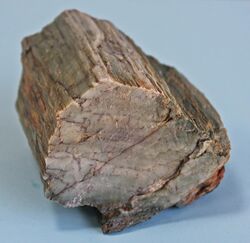Earth:Keratophyre
From HandWiki

Keratophyre from the Neoproterozoic Hatat Formation, Oman
Keratophyre is a volcanic rock of intermediate composition. Although similar to trachyte, keratophyre's plagioclase component is richer in sodium than the plagioclase found in trachyte.[1] Keratophyre forms lava flows and subvolcanic intrusions (dykes and sills). Keratophyre occurs, for example, at Hüttenrode in the Harz Mountains of Germany and in the Berwyn Hills of Wales.[2] Keratophyre tuff of Early Devonian age occurs in Sauerland (Germany).[3]
The term quartz keratophyre has traditionally been used in the Nordic countries to describe a metamorphosed, felsic extrusive rock, corresponding to rhyolite, dacite, or rhyodacite according to IUGS terminology.[4]
References
- ↑ Schermerhorn, L.J.G. (1973). "What is keratophyre?". Lithos 6 (1): 1–11. doi:10.1016/0024-4937(73)90076-5. Bibcode: 1973Litho...6....1S.
- ↑ Jevons, H. Stanley (1904). "Note on the Keratophyres of the Breidden and Berwyn Hills". Geological Magazine 1 (1): 13–16. doi:10.1017/S0016756800119223. Bibcode: 1904GeoM....1...13J. http://journals.cambridge.org/action/displayAbstract?fromPage=online&aid=5067888&fileId=S0016756800119223.
- ↑ Wolf, K. H. (editor) (1981). Handbook of Strata-bound and Stratiform Ore Deposits (Part III volume 9): Regional Studies and Specific Deposits. Amsterdam: Elsevier. pp. 539. ISBN 0-444-41824-5.
- ↑ Slagstad, T. (2003) Geochemistry of trondhjemites and mafic rocks in the Bymarka ophiolite fragment, Trondheim, Norway: Petrogenesis and tectonic implications, Norwegian Journal of Geology, vol. 83, pp. 167-185. Trondheim ISSN 0029-196X
 |

